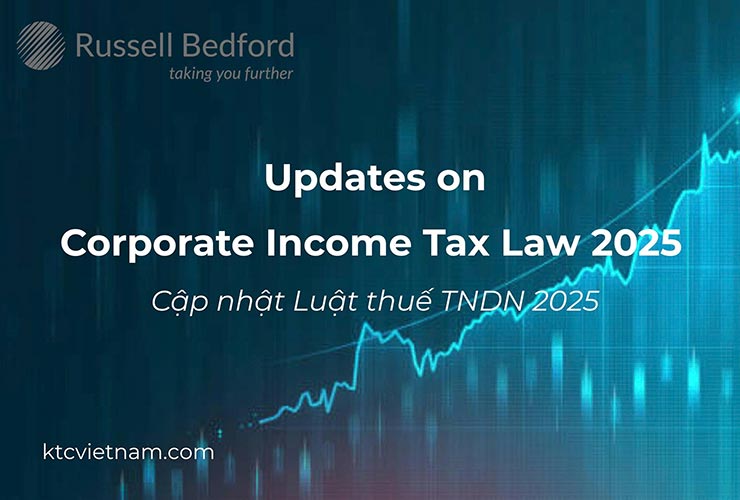The National Assembly has officially passed the Corporate Income Tax Law No. 67/2025/QH15 on 14 June 2025, which will take effect from 1 October 2025, and apply to corporate income tax periods from 2025 onward. Businesses should take note of several key issues when implementing the new Corporate Income Tax Law 2025.
1. Foreign enterprises are subject to tax on all income generated within Vietnam
According to Point d, Clause 2, Article 2, foreign enterprises without a permanent establishment in Vietnam, including those engaged in e-commerce or operating on digital platforms, are required to pay tax on taxable income arising in Vietnam. The law also introduces a new principle for determining taxable income of foreign enterprises in Vietnam: income is deemed taxable if it originates from Vietnam, regardless of the place where business activities are conducted (as stipulated in Clause 3, Article 3).
Impact: The Corporate Income Tax Law 2025 expands its scope of regulation to include foreign enterprises that provide goods and services in Vietnam through e-commerce platforms and digital technology platforms. Vietnamese enterprises should take note when using services provided by foreign suppliers to ensure compliance with their obligations to withhold, declare, and pay taxes on behalf of the suppliers.
2. Reduction in the tax exemption period for income derived from the sale of new technology products.
According to Clause 4, Article 4: Income from the performance of contracts on scientific research and technological development and innovation, and digital transformation; income from the sale of products turned out with technologies applied for the first time in Vietnam; income from the sale of trial products during the period of trial production including trial production conducted under controlled conditions in accordance with legal regulations. Income stated in this clause shall be exempt from tax for a maximum period of 3 years.
Impact: Previously, these types of income were eligible for a tax exemption of up to 5 years; however, the new adjustment limits the exemption period to a maximum of 3 years. This change may influence technology development and digital transformation strategies, prompting enterprises to expedite contract execution and product completion in order to optimize the tax incentives available within the shortened exemption period.
3. Expanding tax exemption subjects
Several new types of income have been added to the list of tax-exempt categories under Clause 10, Article 4. These include income from the initial transfer of carbon credits after issuance, and income from interest and the initial transfer of green bonds after issuance.
Impact: Enterprises operating in this sector should pay close attention to incentive policies related to the initial transfer of carbon credits after issuance, as well as income from interest and the initial transfer of green bonds after issuance, in order to maximize potential benefits. In addition, this provision establishes a mechanism to encourage businesses across various sectors to innovate and transition toward sustainable and environmentally friendly technologies.
4. Losses from real estate transfers are allowed to be offset against taxable income.
According to Clause 3, Article 7: in cases of losses incurred in the business operations, the losses can be offset against the taxable income of other business operations generating income, as chosen by the enterprise (except for business operations currently enjoying tax incentives).
Impact: Previously, losses arising from real estate transfers could not be offset against profits from other business operations. Under the new regulation, enterprises are now permitted to offset such losses against income from other business operations. This change may help reduce the financial burden on real estate companies in cases of unfavorable business conditions that lead to project liquidation. However, it is important to note that losses from real estate transfers cannot be offset if the income is currently benefiting from tax incentives
5. Amendments to regulations on deductible expenses
Compared to previous regulations, Article 9 of the Corporate Income Tax Law 2025 introduces several amendments to the rules on deductible expenses when determining taxable income, as follows:
a. Additional deductible expenses include:
- actual expenses for seconded personnel involved in governance, management, and supervision of credit institutions put under special control;
- expenses incurred for the enterprise’s production and business activities that are not directly matched with revenue generated in the same period;
- contributions to the construction of public infrastructure that also serves the enterprise’s production and business activities;
- expenses related to the reduction of greenhouse gas emissions associated with the enterprise’s business operations;
- and contributions to funds established by the Prime Minister or the Government.
b. Input value-added tax (VAT) that has not been fully credited and is not eligible for refund is now allowed to be included as a deductible expense.
Impact: The inclusion of additional deductible expenses when determining taxable corporate income and the unrecovered VAT being allowed as deductible expenses makes it more convenient for businesses in their operations. This is more aligned with the actual business activities of enterprises.
6. Cases eligible for tax rate of 15% or 17%
Article 10 introduces new provisions on preferential tax rates, including a 15% tax rate for enterprises with total annual revenue of less than VND 3 billion, and a 17% tax rate for those with total annual revenue between VND 3 billion and VND 50 billion.
Impact: Under the new regulations, a large number small and medium enterprises with annual revenue below VND 50 billion will be eligible for the reduced tax rates of 15% or 17%. Previously, most enterprises were subject to a standard CIT rate of 20%, (except for those involved in oil and gas exploration, exploitation of rare natural resources, or those eligible for preferential tax treatments). Along with the new, stricter regulations on the management of household and individual businesses, the reduced CIT rates may encourage these entities to transition into enterprises once they reach a certain scale.
7. High-Tech Agricultural Zones eligible for tax incentives
Article 13: high-tech agricultural zones are now included as eligible locations for corporate income tax incentives.
Impact: The inclusion of high-tech agricultural zones represents a significant advancement compared to previous regulations, encouraging agricultural enterprises to adopt and invest in high-tech applications. In addition, it provides a basis for planning designated areas for the development of high-tech agriculture, facilitating management and attracting investment in a manner similar to industrial zones or concentrated technology parks.
8. Adjustment to preferential tax rate for new automotive manufacturing and assembly projects
Clause 4, Article 13: new investment projects in automobile manufacturing and assembly are now entitled to a preferential tax rate of 17% for a period of 10 years.
Impact: Previously, such projects were eligible for a 10% tax rate for 15 years, which was substantial and within a long period. The new regulation represents a reduction in both the preferential rate and the duration, and enterprises should take this into account when planning their business strategies.
9. Projects supporting small and medium enterprises eligible for a 17% preferential tax rate for 10 years
Clause 4, Article 13 expands the list of beneficiaries eligible for the 17% preferential tax rate for a period of 10 years. This includes investment projects involving the development and operation of technical facilities supporting small and medium enterprises (SMEs), SME incubators, and co-working spaces for innovative start-ups, as defined under the Law on Provision of Assistance for Small and Medium-sized Enterprises.Impact: The addition of these eligible projects aims to promote and create favorable conditions for the growth of SMEs, encouraging innovation and entrepreneurship within this important sector.




















